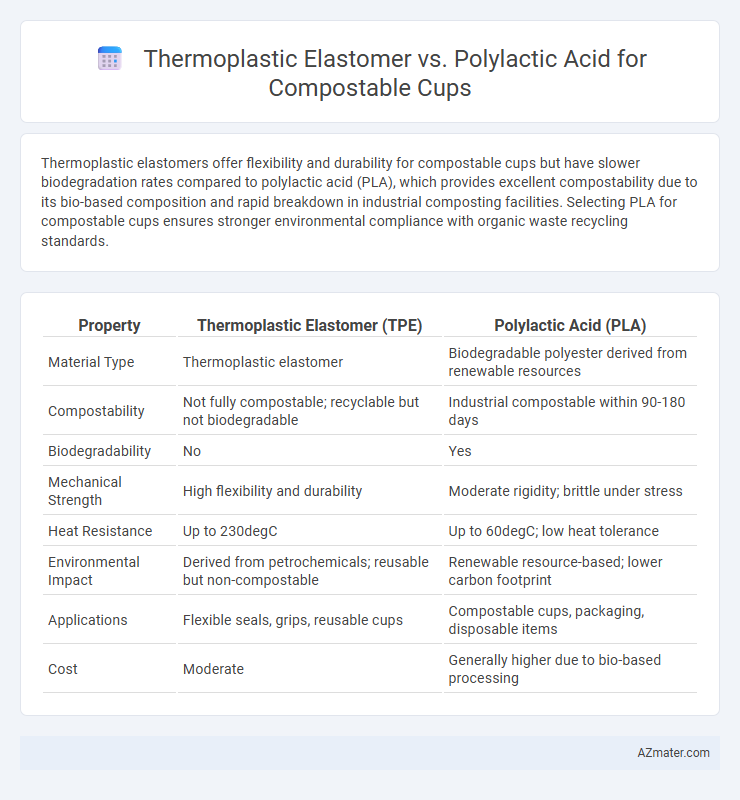Thermoplastic elastomers offer flexibility and durability for compostable cups but have slower biodegradation rates compared to polylactic acid (PLA), which provides excellent compostability due to its bio-based composition and rapid breakdown in industrial composting facilities. Selecting PLA for compostable cups ensures stronger environmental compliance with organic waste recycling standards.
Table of Comparison
| Property | Thermoplastic Elastomer (TPE) | Polylactic Acid (PLA) |
|---|---|---|
| Material Type | Thermoplastic elastomer | Biodegradable polyester derived from renewable resources |
| Compostability | Not fully compostable; recyclable but not biodegradable | Industrial compostable within 90-180 days |
| Biodegradability | No | Yes |
| Mechanical Strength | High flexibility and durability | Moderate rigidity; brittle under stress |
| Heat Resistance | Up to 230degC | Up to 60degC; low heat tolerance |
| Environmental Impact | Derived from petrochemicals; reusable but non-compostable | Renewable resource-based; lower carbon footprint |
| Applications | Flexible seals, grips, reusable cups | Compostable cups, packaging, disposable items |
| Cost | Moderate | Generally higher due to bio-based processing |
Introduction to Compostable Cup Materials
Thermoplastic elastomers (TPE) offer flexibility and durability but often lack full compostability, making them less ideal for eco-friendly cup applications. Polylactic acid (PLA), derived from renewable resources like corn starch, provides excellent biodegradability and compostability under industrial conditions, which aligns well with sustainable single-use cup requirements. Understanding the material properties and composting standards is essential for selecting the appropriate compostable cup material that meets environmental regulations and consumer expectations.
Overview of Thermoplastic Elastomer (TPE)
Thermoplastic elastomers (TPE) combine the elasticity of rubber with the processability of plastics, making them suitable for flexible, durable compostable cups. They exhibit excellent resistance to heat, chemicals, and abrasion while offering recyclability through repeated melting and reshaping. TPE's ability to maintain mechanical properties under varying environmental conditions distinguishes it from rigid bioplastics like polylactic acid (PLA) in sustainable packaging applications.
Overview of Polylactic Acid (PLA)
Polylactic acid (PLA) is a biodegradable thermoplastic derived from renewable resources like corn starch and sugarcane, making it an environmentally friendly alternative for compostable cups. It offers excellent clarity and stiffness, with high biodegradability under industrial composting conditions, decomposing within 90 to 180 days. PLA's compostability and low carbon footprint make it a preferred material over traditional thermoplastic elastomers, which are typically less biodegradable and derived from fossil fuels.
Material Properties: TPE vs PLA
Thermoplastic elastomers (TPE) offer excellent flexibility, impact resistance, and durability, making them suitable for reusable compostable cups that require elasticity and long-term performance. Polylactic acid (PLA) is a rigid, biodegradable polymer derived from renewable resources, providing strong rigidity and clarity but lower heat resistance and brittleness compared to TPE. While PLA is compostable under industrial conditions, TPE's compostability depends on specific formulations and may require blending with biodegradable additives to meet compostable standards.
Environmental Impact and Compostability
Thermoplastic elastomers (TPE) offer durability and flexibility but typically have limited biodegradability and compostability compared to Polylactic acid (PLA), which is a bio-based polymer derived from renewable resources like corn starch. PLA demonstrates superior compostability under industrial composting conditions, breaking down into carbon dioxide, water, and biomass within 90 to 180 days, whereas TPEs often persist in the environment longer due to their synthetic origins. The environmental impact of PLA is generally lower due to its carbon-neutral life cycle and reduced reliance on fossil fuels, making it a more sustainable option for compostable cups.
Manufacturing and Processing Differences
Thermoplastic elastomers (TPE) for compostable cups process through injection molding or extrusion with moderate temperatures around 180-230degC, allowing flexibility and durability while maintaining quick cycle times. Polylactic acid (PLA) requires precise temperature control during injection molding or thermoforming at 170-190degC to prevent polymer degradation and ensure clarity and rigidity in the cup structure. Manufacturing with TPE offers enhanced elasticity and impact resistance, whereas PLA provides a compostable, stiff material but demands stricter moisture and thermal management during processing to maintain biodegradability.
Performance in Compostable Cup Applications
Thermoplastic elastomers (TPE) provide excellent flexibility and durability, improving impact resistance and comfort in compostable cups, whereas polylactic acid (PLA) offers high stiffness and clarity but can be brittle under stress. PLA compostable cups tend to degrade faster in industrial composting environments due to their biodegradability, while TPE-enhanced cups may require optimized blends to achieve comparable compostability without sacrificing mechanical performance. The balance between mechanical performance and compostability makes PLA more suitable for single-use cups, but TPE blends can extend the application range by enhancing resilience and heat tolerance in compostable cup production.
Cost Comparison: TPE and PLA
Thermoplastic elastomers (TPE) generally have higher raw material costs compared to polylactic acid (PLA), impacting overall production expenses for compostable cups. PLA, derived from renewable resources like cornstarch, tends to be more cost-effective due to established supply chains and economies of scale in bioplastic manufacturing. However, TPE offers superior flexibility and durability, which may justify premium pricing in certain compostable cup applications despite higher material costs.
Regulatory and Certification Standards
Thermoplastic elastomers (TPE) and polylactic acid (PLA) differ significantly in regulatory and certification standards for compostable cups. PLA is widely accepted under ASTM D6400 and EN 13432 certifications, ensuring industrial compostability compliance, whereas TPE often lacks standardized compostability certifications due to its synthetic nature. Regulatory bodies favor PLA for food-contact safety and environmental claims, making it the preferred material for certified compostable cups.
Conclusion: Which Material Suits Compostable Cups Best?
Thermoplastic elastomers (TPE) offer flexibility and durability but lack the biodegradability needed for truly compostable cups, whereas polylactic acid (PLA) excels in compostability due to its plant-based origins and ability to break down in industrial composting facilities. PLA's compostable nature aligns with environmental sustainability goals, making it the preferred choice for single-use, compostable cup applications. Selecting PLA ensures regulatory compliance and meets consumer demand for eco-friendly, biodegradable packaging solutions.

Infographic: Thermoplastic elastomer vs Polylactic acid for Compostable cup
 azmater.com
azmater.com